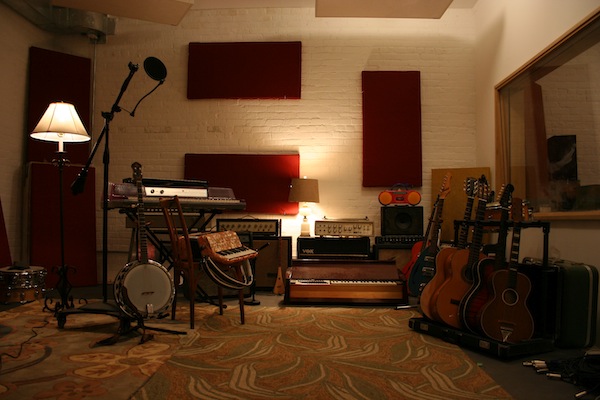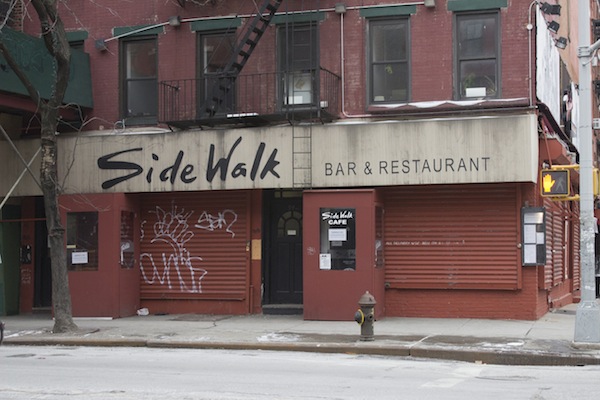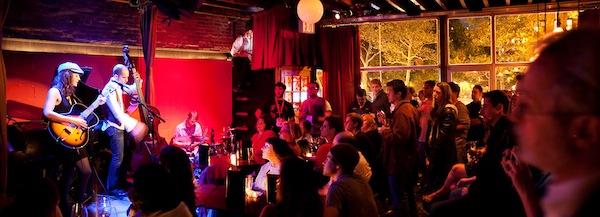
THIS IS BROOKLYN COUNTRY
Videos by American Songwriter
Miller says Brooklyn is now the center of the music scene. “Thetruth is, the Lower East Side is very different than it used to be and you’ll be mostly playing in Brooklyn,” he says.
It’s thirteen miles from Newtown Creek in Greenpoint to Coney Island (by bike), so one part of Brooklyn is quite far from another. Olivia Mancini points out, “New York abounds with venues and with people who might not be able to see you on a given Saturday but will come out if you’re playing their neighborhood the following Tuesday.”
Over and over, artists cited Jalopy in Red Hook and Pete’s Candy Store in Williamsburg as among their favorites. “Pete’s has the bonus of being a converted old railroad car with a warm, old-timey vibe,” adds Mancini.
Pete’s talent booker Jake Silver says, “I seek a spark, something that instantly engages me, draws me in, makes me want to hear more. It doesn’t have to be a polished recording, just something that takes me out of the world I’m in and into the world of the artist.” He also admonishes, ‘Be friendly to the staff!”
Not far from Pete’s on one of the most trafficked blocks in Williamsburg is Spike Hill. Mancini says, “I always have a great time at Spike Hill. It’s usually free admission and consequently boasts appreciative and attentive audiences. I love Rocket Hub’s open mic on Tuesday nights. Always eclectic, often inspirational, the weekly lineups draw performers from all over the city.”
Gustavo Rodriguez books Spike Hill and plays in the band Brian & Silbin. He also books Queens’ LIC Bar, a songwriter-friendly venue to which The Who donated a PA after Hurricane Sandy. Rodriguez says, “Ideally, I want artists that are ready both artistically and in terms of audience/following – and artists that know how to put on ashow! They don’t have to wear leopard skin and jump off of amps but they have to have some kind of on stage presence and charisma that will connect with an audience, something that lets people in.”
Rodriguez recommends thick skin, saying, “This is a tough town to be an artist. Manage your expectations and get ready to be tested. Don’t come here thinking there’s clubs full of people just waiting to hear your original music.” He also recommends, “Don’t book shows every night of the week. You will wear out your welcome with venues very quickly.”
Jalopy is the center of the traditional scene. Tuesday is open mic night but Jalopy goes one further in fostering community, offering classes and workshops on everything from clawhammer banjo to harmony singing and selling affordable, vintage instruments. Morgan O’Kane – whose hard-driving album The One They Call Wind just came out – enjoys Roots & Ruckus on Wednesdays, which showcases traditional folk performers in half hour sets. “It’s a great night for anyone ready to play their heart out for a great crowd in a great space.”
Country musicians gravitate to Skinny Dennis in Williamsburg, which has a steady, younger crowd and Hank’s Saloon in Boerum Hill, which may have a population of middle-aged drunks or of rowdy fans, depending on the night. Rockabilly/noir singer Ruby Rae once played a show during which Jimmy Fallon wandered in.
The city’s best old-time music jam takes place on Mondays at Lowlands Bar in Gowanus while the recently re-opened Sunny’s in Red Hook, which saw significant damage in Hurricane Sandy, hosts a Saturday night old-time, folk, and bluegrass jam.
Newer venues are constantly opening – or reopening – continuing to disburse the scene. Russo attests, “The scene is the same old thing, I just need a bike to get to it [now].” Freddy’s, a beloved Prospect Heights joint immortalized in song by Andy Friedman, was forced to close when The Barclay’s Center was built, reopening several years later in South Slope. The most recent roots music venues to open are Bootleg in Bushwick, Beast of Bourbon in Bedford-Stuyvesant, and Bar Chord in Ditmas Park. Opened in 2013, Baby’s All Right has become a standard bearer for indie rock. Russ says, “They treat bands really well and the sound is great.”
Shimmy says, “Whether the venues for the music you’re into are in Ridgewood, Park Slope, or Spanish Harlem, just go where the music is good.”

SWUNG ON MY OLD GUITAR, GRABBED HOLD OF A SUBWAY CAR
Non-traditional shows are on the upswing. Miller remembers, “My first show was at a farmers market in Fort Greene.” Brooklyn and Queens are home to numerous DIY venues, many of which are in Bushwick.
Banjo player Morgan O’Kane – whose hard-driving album The One They Call The Wind just came out – often plays for tips in the subways. He says, “Busking in NYC has been really good to me. It’s a beautiful experience and I wouldn’t trade it for anything.”
Busking also used to be a part of Miller’s earnings. “I would work in parks. I’d set up near the Central Park Zoo or ice skating rinks or in other parks where families hang out and are just looking to have fun. Sometimes you’ll only make five dollars in two hours, but sometimes I made hundreds.”

57 VENUES (SOME OF THEM GONE)
Backwords has played 57 different New York venues. Russ says, “We still haven’t figured it all out – in terms of making a living out of the art – but when you think about it almost no one ever does. In New York City, there are at least a thousand really good bands. When you start taking it all in, you see the beauty of this community. In the long run, sure, one or two bands will rise up, get signed, and become household names, but it’s more so about challenging each other. It can be difficult to circle back to the reasons you came here in the first place – but when you focus on those – they always revolve around – you came here because you had an artistic vision inside of you that only Brooklyn or NYC could bring out.”
Miller says, “It’s a great town for a working musician. You can play five nights a week and get paid, but it’s a hard town to get discovered in. [But] all of the opportunities to play live and the competition will make you a much, much better performer and musician.”
Many things in New York have changes since Levon Helm encapsulated his experience in the documentary The Last Waltz, but some aspects of the NYC experience remain the same. “New York, it was an adult portion. It was an adult dose. So it took a couple of trips to get into it. You just go in the first time and you get your ass kicked and you take off. As soon as it heals up, you come back and you try it again. Eventually, you fall right in love with it.”

2 Comments
Leave a Reply